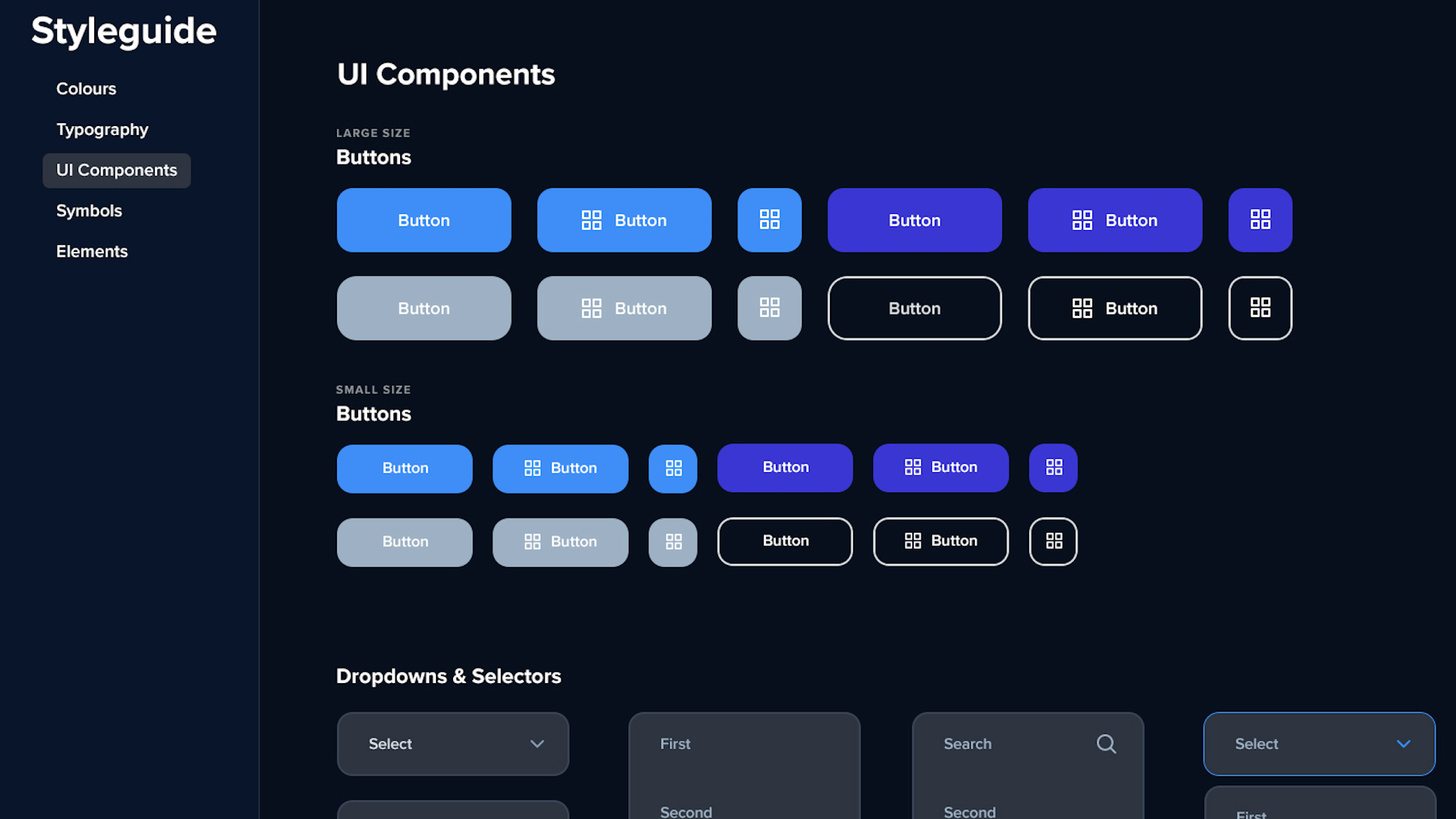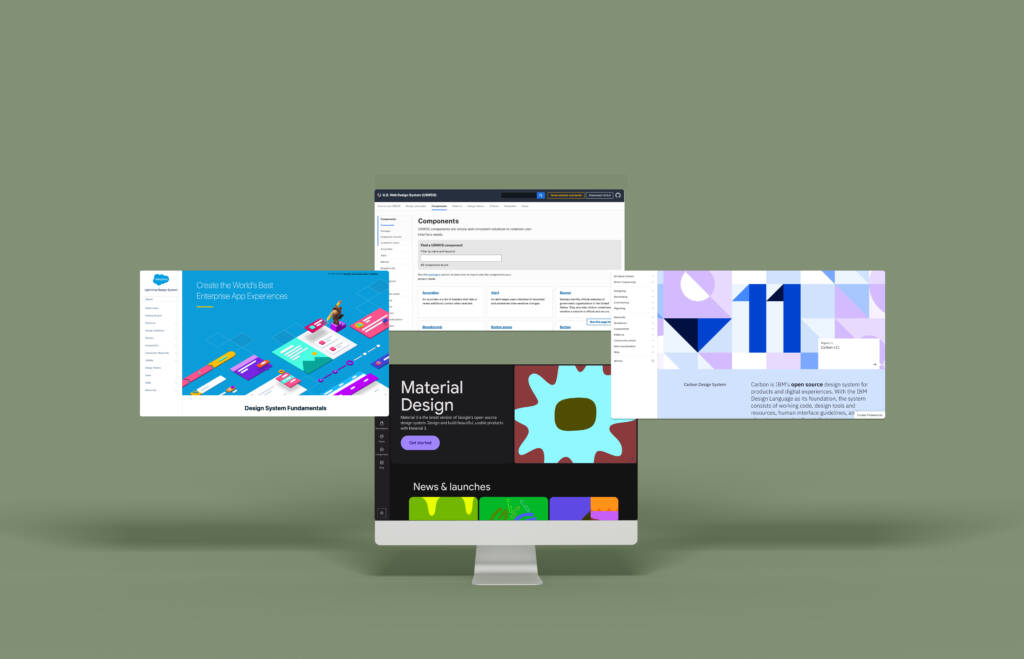In today’s digitally-driven world, where user experience and user interface design are paramount for shaping consumer perceptions and driving engagement, the adoption of design systems has become increasingly indispensable for organizations aiming to flourish in the digital realm. At Tentackles, we are deeply committed to harnessing the power of design systems to empower businesses for digital success.
Through our expertise in UX/UI design and our dedication to crafting robust design systems, we assist organizations in establishing a strong digital presence, standing out in competitive markets, and ultimately achieving their business goals. By embracing design systems, companies can streamline their design processes, foster innovation, and deliver unparalleled value to their customers, positioning themselves as leaders in the ever-evolving digital landscape.
Prominent Examples of Design Systems

Design systems transcend mere collections of design elements; they encapsulate the very essence of an organization’s brand identity, values, and vision. By consolidating design principles, patterns, components, and guidelines, design systems offer a holistic framework for crafting consistent digital experiences across various platforms and touchpoints.
Acting as a centralized repository of design assets and best practices, they serve as the definitive source of truth, ensuring cohesion and alignment across all digital endeavours.
Leveraging Design Systems for Success
Regardless of the specific design system used, the benefits remain consistent: increased efficiency, improved consistency, enhanced usability, and scalability. By adopting and implementing a design system tailored to their needs, organizations can streamline their design and development processes, accelerate time-to-market, and deliver superior digital experiences to their users.
Driving Efficiency and Consistency
A primary advantage of design systems lies in their ability to streamline the design and development process. By establishing standardized design elements and patterns, design systems eliminate redundancy and expedite workflows, resulting in accelerated time-to-market and enhanced operational efficiency.
Designers and developers can leverage predefined components and guidelines to create cohesive digital products, thereby maintaining consistency in design execution and user experience.
Empowering Creativity and Innovation
Contrary to the misconception that design systems stifle creativity, they actually foster a conducive environment for innovation. By providing a robust foundation of reusable components and design principles, design systems empower teams to focus their creative energies on solving complex problems and exploring novel ideas.
Freed from the constraints of repetitive tasks, designers can experiment, iterate, and push the boundaries of conventional design paradigms, ultimately leading to breakthrough innovations and differentiated digital experiences.
Cultivating Cross-Functional Collaboration
Effective collaboration is indispensable in today’s multidisciplinary work landscape, and design systems serve as a catalyst for seamless collaboration across diverse teams and stakeholders. By establishing a common language and set of standards, design systems facilitate communication and alignment between designers, developers, product managers, and other stakeholders.
Clear documentation and guidelines ensure that everyone is working towards a shared vision, fostering synergy and driving collective efforts towards achieving organizational objectives.
Scaling for Growth and Adaptability
As organizations expand and evolve, their digital presence must scale accordingly to meet the demands of a dynamic market landscape. Design systems offer scalability and adaptability, enabling businesses to grow and innovate without sacrificing coherence or quality.
Whether it’s launching new products, entering new markets, or adapting to emerging technologies, design systems provide a flexible framework that can accommodate change while preserving brand identity and user experience excellence.
Prominent Examples of Design Systems

- Material Design: Developed by Google, Material Design is a comprehensive design system that offers guidelines, components, and tools for creating visually consistent and engaging digital experiences across platforms. With its emphasis on material surfaces, bold colors, and intuitive interactions, Material Design has become a popular choice for designers and developers worldwide.
- Salesforce Lightning Design: Salesforce Lightning Design System provides a cohesive set of design patterns, components, and guidelines for building enterprise applications within the Salesforce ecosystem. It enables organizations to create unified user experiences that seamlessly integrate with Salesforce’s suite of cloud-based services.
- IBM’s Carbon Design System: IBM’s Carbon Design System offers a robust set of design assets and guidelines for creating enterprise-grade digital products and experiences. With its focus on accessibility, modularity, and flexibility, Carbon empowers designers and developers to build cohesive and scalable solutions that align with IBM’s brand identity and values.
- US Web Design System (USWDS): Developed by the United States Digital Service (USDS) and 18F, the US Web Design System provides a library of reusable components and guidelines for creating accessible, responsive, and user-friendly government websites. It serves as a standardized framework for federal agencies to deliver consistent and cohesive digital experiences to the public.
In conclusion, the strategic adoption of design systems is paramount for organizations seeking to excel in the digital arena. By harnessing the power of design systems, businesses can achieve operational efficiency, foster creativity and innovation, cultivate collaboration, and scale for growth with agility and resilience.
Design systems not only streamline the design process but also serve as a foundation for consistent branding and user experience across various digital platforms, enhancing brand recognition and trust among consumers.
At Tentackles, we are committed to empowering our clients with bespoke design systems tailored to their unique needs and aspirations. With our expertise in UX/UI design and our dedication to staying at the forefront of design trends and technologies, we collaborate closely with organizations to develop design systems that not only meet their current requirements but also anticipate future challenges and opportunities.
Together, let us embark on a journey towards design-driven excellence, where every digital interaction is an opportunity to captivate and delight users, driving sustained success in the dynamic and competitive digital landscape.


